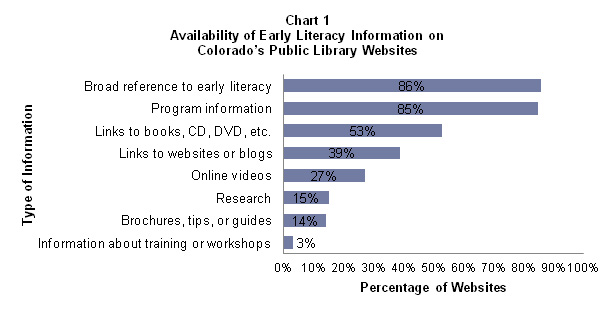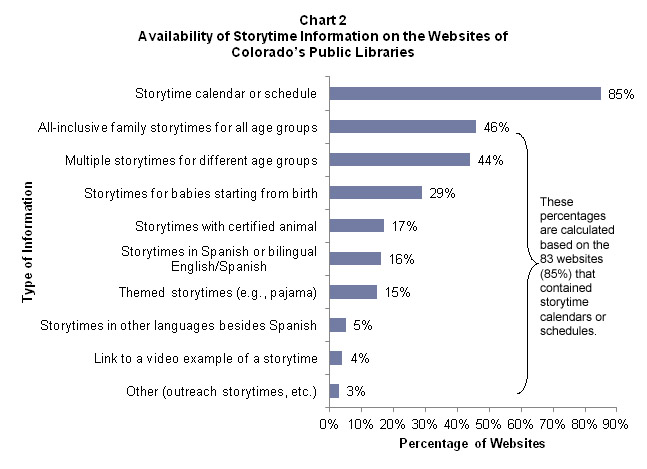Public libraries have the opportunity to play a central role in educating parents on the benefits of developing children’s early literacy skills.[note]Ghoting, S. N., & Martin-Díaz, P. (2006). Early Literacy Storytimes @ your library. Chicago, IL: American Library Association, p. 6.[/note] With more people accessing information through public library websites, a study was conducted in Spring 2012 to determine the availability of early literacy information on the websites of Colorado’s public libraries. (This study was undertaken as a University of Denver Master of Library and Information Science program capstone research project. For more details, including the survey instrument, see http://snurl.com/earlyliteracy.)
Early literacy is “what children know about reading and writing before they actually read and write.” (Ghoting, S. N., & Martin-Díaz, P. (2006). Early Literacy Storytimes @ your library. Chicago, IL: American Library Association, p. 6.)
Because libraries use literacy-based storytimes to engage both parents and children, and because reading aloud is an essential building block for developing early literacy skills, this study investigated what types of information about early literacy, storytimes, and reading aloud were available on Colorado public library websites.[note]Eleven of Colorado’s 114 public library jurisdictions do not have websites. Except where noted otherwise, the percentages in this Fast Facts are calculated based on the 103 libraries with websites.[/note]
This Fast Facts reports highlights from the study, which found that most websites broadly referenced early literacy information and contained storytime information. However, a lower percentage had a specific definition of the term “early literacy,” referenced early literacy skills, or had information on the importance of reading aloud.
Early Literacy Information
More than 4 in 5 libraries (86%) had a broad reference to early literacy (e.g., description of, links to resources, etc.) somewhere on their website (see Chart 1). Eighty-five percent featured programs including storytimes, summer reading, and/or other early literacy initiatives. More than half of libraries (53%) had links to media (books, CDs, DVDs, etc.) or media lists for children ages 0 to 5, such as the Notable Children’s Books List by the American Library Association (ALA) or lists developed by the library itself. Almost 2 in 5 libraries (39%) linked to websites such as Great Websites for Kids by the Association for Library Service to Children (ALSC) and children’s e-book sites (e.g., Tumblebooks, StoryHour, etc.). Only about 1 in 7 referenced early literacy research on their website (15%), and/or provided early literacy brochures, tips, or guides (14%). Less than 5 percent had information on early literacy training or workshops.
In addition to the general types of early literacy information discussed above, the websites were also analyzed for specific content about early literacy, including:
- Discussion of long-term benefits: A small percentage of library websites contained specific information on the long-term positive effects of building early literacy skills. Just about 1 in 10 libraries (12%) linked early literacy skills to improved school readiness. Other benefits of building early literacy skills, such as contributing to healthy early brain development and later success in life, were mentioned even less frequently.
- Definition of “early literacy” and description of early literacy skills: Only 7 percent of libraries had a brief definition of the term “early literacy,” while 15 percent had a description of early literacy skills on their websites.
- Information on the importance of reading aloud: Fifteen percent of libraries had information on the importance of reading aloud to children as a way to build early literacy skills. Just 8 percent highlighted the importance of reading aloud to babies beginning from birth and/or reading aloud every day.
Information on Storytimes on Library Websites
Of the 104 libraries that offered storytimes in 2011,[note]Based on 2011 Public Library Annual Report data: http://www.lrs.org/pub_stats.php.[/note] 98 had websites. Of these 98, 85 percent posted their storytime schedule or calendar on their websites (see Chart 2). Nearly half of these libraries (46%) offered all-inclusive family storytimes for all age groups, and a similar percentage (44%) offered separate storytimes for different age groups, e.g. baby, toddler, and preschool. Some libraries offered both. Almost 1 in 3 libraries (29%) offered storytimes for babies beginning from birth. About 1 in 6 libraries offered storytimes with a certified animal (17%) and/or in Spanish or bilingual English and Spanish (16%), and 15 percent offered themed storytimes (e.g., pajama). Just 1 in 20 libraries (5%) offered storytimes in languages other than Spanish, including American Sign Language, Russian, and French. Less than 5 percent linked to a video example of storytime (4%),[note]Not including StoryBlocks videos.[/note] or contained “other” storytime information (e.g., outreach storytimes, etc.) (3%).
Almost 1 in 3 Colorado public libraries (29%) offer storytimes specifically for babies beginning from birth, based on schedule information available on their websites.
Early Literacy Information in Languages Other Than English
One in 6 libraries (17%) provided early literacy information on their websites in Spanish. In contrast, just 1 in 16 libraries (6%) provided early literacy information in other languages besides Spanish on their websites. Examples of information resources included links to ¡Colorín Colorado! and the International Children’s Digital Library, early literacy handouts in Spanish, and a button on the homepage to translate the website into another language.
Link to StoryBlocks Videos
In 2008, Colorado Libraries for Early Literacy (CLEL) launched www.clel.org to bring together information about library early literacy programs and services in Colorado and to provide tools and resources for library staff. In 2009, CLEL developed StoryBlocks in partnership with Rocky Mountain PBS. StoryBlocks is a collection of 30- to 60-second videos designed to model songs, rhymes, and fingerplays in both English and Spanish to parents, caregivers, and library staff. Each video clip includes helpful early literacy tips to increase caregivers’ understanding of child development and pre-literacy needs. Close to 1 in 5 libraries (18%) provided a link to StoryBlocks videos on their websites.
Conclusion
Results of this study indicate that Colorado’s public libraries have the possibility of promoting substantially more early literacy information on their websites. There is a real opportunity for Colorado’s public libraries to more fully use their websites to demonstrate the library’s critical role in educating parents, caregivers, and early childhood educators on the benefits of developing children’s early literacy skills.
The Colorado State Library has an online early literacy resource guide with a selection of recommended best practices that libraries can copy and paste onto their own websites that includes:
- A definition of the term “early literacy”
- Descriptions of the Every Child Ready to Read @ your Library® (ECCR) early literacy skills and activities[note]Every Child Ready to Read @ your Library® is a research-based early literacy skills program jointly developed by ALSC and the Public Library Association (PLA). See http://everychildreadytoread.org/ for more information.[/note]
- Research-based information about the long-term effects and benefits of building early literacy skills
- Information about the importance of reading aloud everyday to both children and babies beginning from birth
- Links to StoryBlocks videos of songs and rhymes in both English and Spanish
Copy and paste early literacy resources onto your library’s website from the Colorado State Library’s Online Early Literacy Resource Guide: http://www.cde.state.co.us/cdelib/LibraryDevelopment/YouthServices/downloads/pdf/EarlyLiteracyOnlineResourceGuide.pdf

